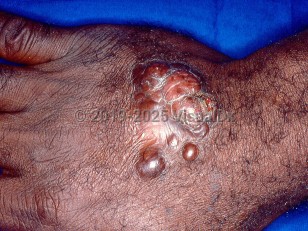Lobomycosis
Alerts and Notices
Important News & Links
Synopsis

Lobomycosis, also known as Jorge Lobo disease or keloidal blastomycosis, is a chronic cutaneous and subcutaneous fungal disease endemic to tropical and subtropical regions of Central and South America. The organism, Lacazia loboi (previously Loboa loboi), is a fungus, which, to date, can be cultured only in vivo.
The onset of lobomycosis is insidious and progresses over decades. The incubation period is months to years. The fungus grows at temperatures lower than 37°C (98.6°F), such that spread of the infection systemically does not occur. There is often a history of antecedent trauma and subsequent environmental exposure (often water).
There is a strong male predominance (approximately 90% of cases), probably related to occupational exposure (eg, agriculture).
There may be genetic factors increasing the risk of infection as certain American Indian tribes of Brazil are frequently infected; however, specific genetic markers have not been identified. This disease is very rare in travelers, and the first case in an American traveler was reported in 2000.
Dolphins are the only animal that can carry lobomycosis.
Lobomycosis clinically manifests as papules, nodules, and cauliflower-like keloidal lesions on exposed or cooler regions of the body, such as the lower extremities or ears. The most common presentation is a nodular keloid that slowly enlarges over years. The lesion may remain solitary, slowly expand within a localized region, or disseminate to other areas of the body. While regional lymph node involvement may occur, lobomycosis does not disseminate systemically.
The skin lesions grow slowly, and symptoms are often mild, such as mild pruritus or pain with trauma to the lesions. Therefore, there is often a delay in making the diagnosis.
The onset of lobomycosis is insidious and progresses over decades. The incubation period is months to years. The fungus grows at temperatures lower than 37°C (98.6°F), such that spread of the infection systemically does not occur. There is often a history of antecedent trauma and subsequent environmental exposure (often water).
There is a strong male predominance (approximately 90% of cases), probably related to occupational exposure (eg, agriculture).
There may be genetic factors increasing the risk of infection as certain American Indian tribes of Brazil are frequently infected; however, specific genetic markers have not been identified. This disease is very rare in travelers, and the first case in an American traveler was reported in 2000.
Dolphins are the only animal that can carry lobomycosis.
Lobomycosis clinically manifests as papules, nodules, and cauliflower-like keloidal lesions on exposed or cooler regions of the body, such as the lower extremities or ears. The most common presentation is a nodular keloid that slowly enlarges over years. The lesion may remain solitary, slowly expand within a localized region, or disseminate to other areas of the body. While regional lymph node involvement may occur, lobomycosis does not disseminate systemically.
The skin lesions grow slowly, and symptoms are often mild, such as mild pruritus or pain with trauma to the lesions. Therefore, there is often a delay in making the diagnosis.
Codes
ICD10CM:
B48.0 – Lobomycosis
SNOMEDCT:
47306003 – Lobomycosis
B48.0 – Lobomycosis
SNOMEDCT:
47306003 – Lobomycosis
Look For
Subscription Required
Diagnostic Pearls
Subscription Required
Differential Diagnosis & Pitfalls

To perform a comparison, select diagnoses from the classic differential
Subscription Required
Best Tests
Subscription Required
Management Pearls
Subscription Required
Therapy
Subscription Required
References
Subscription Required
Last Reviewed:11/15/2022
Last Updated:08/20/2025
Last Updated:08/20/2025
Lobomycosis

